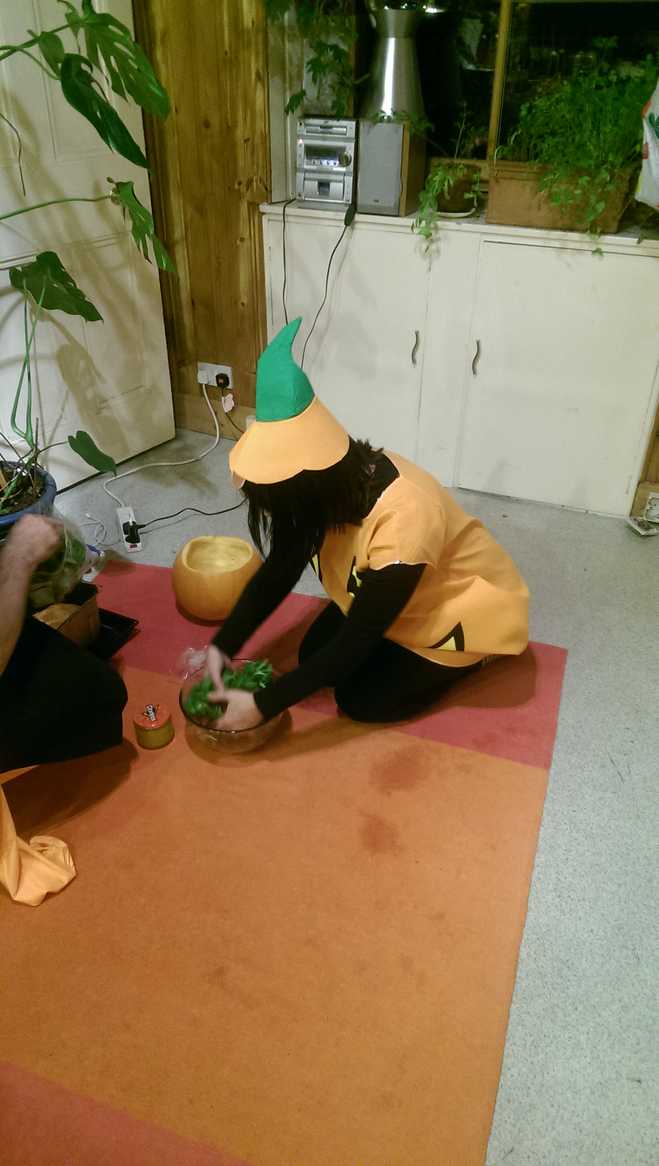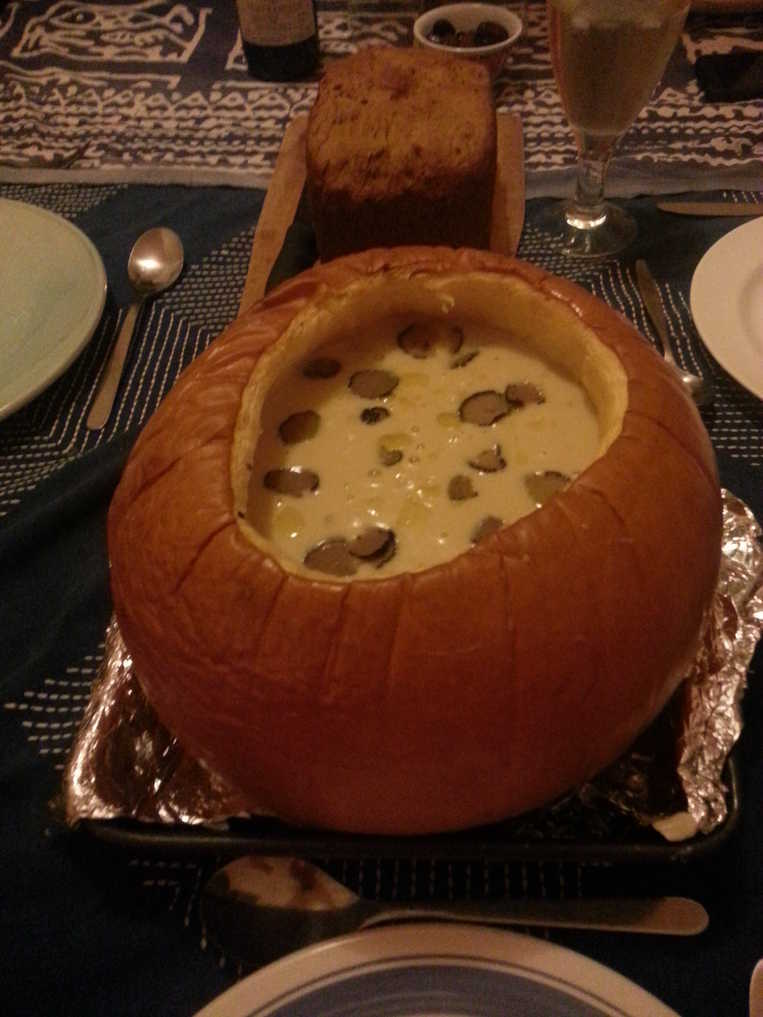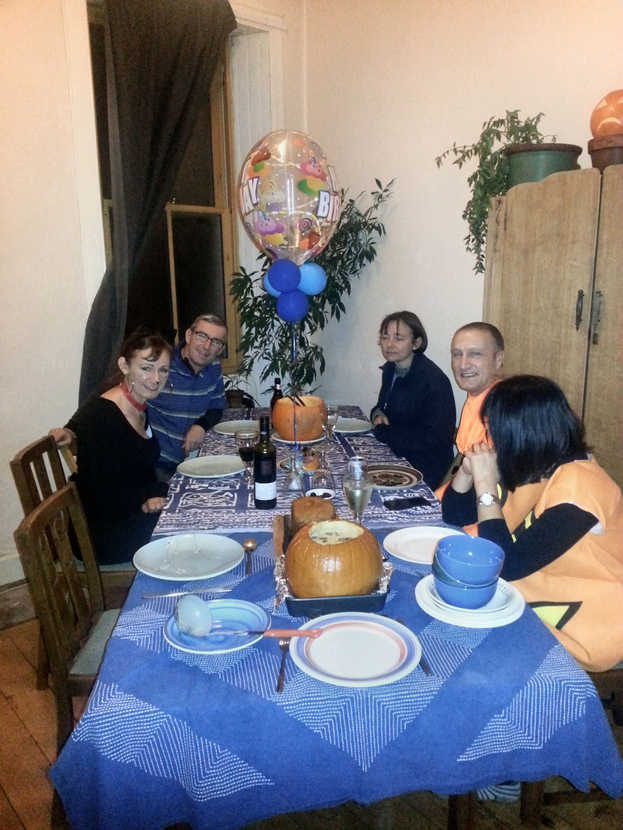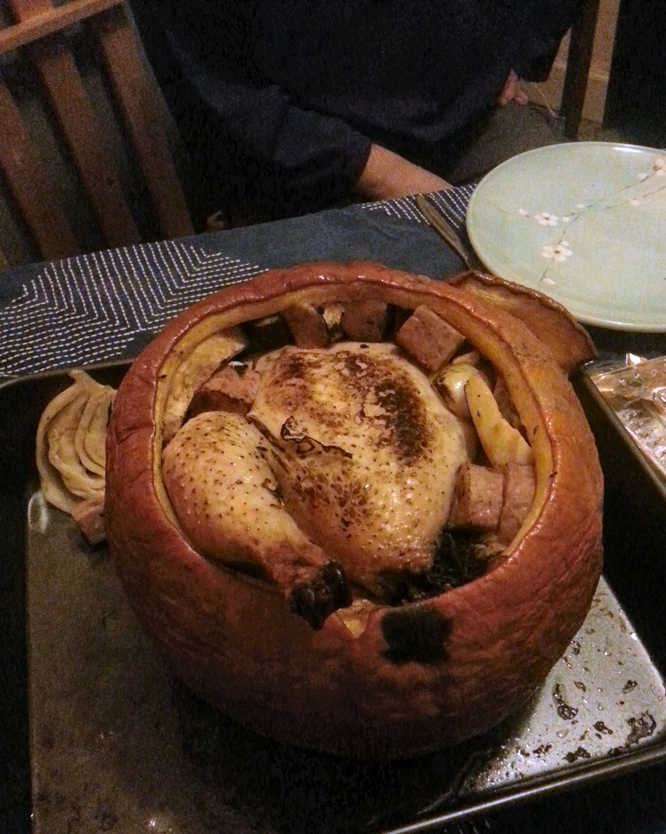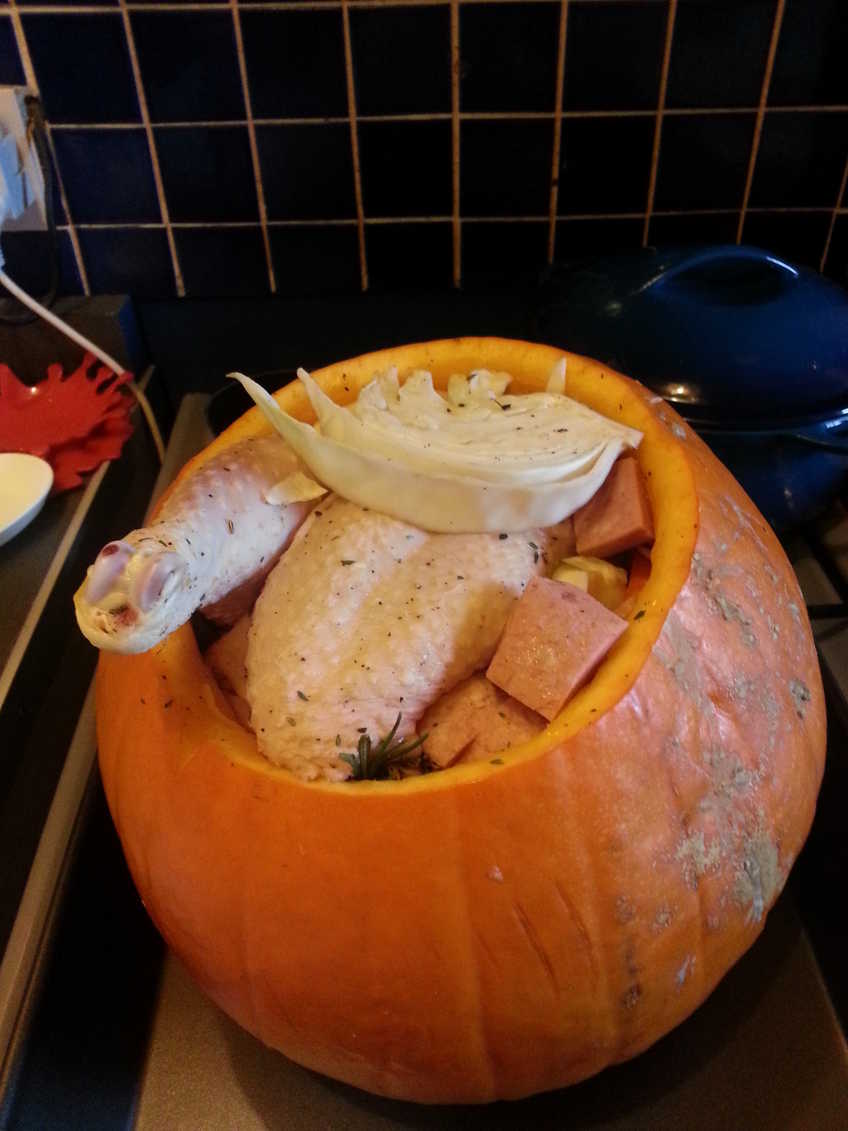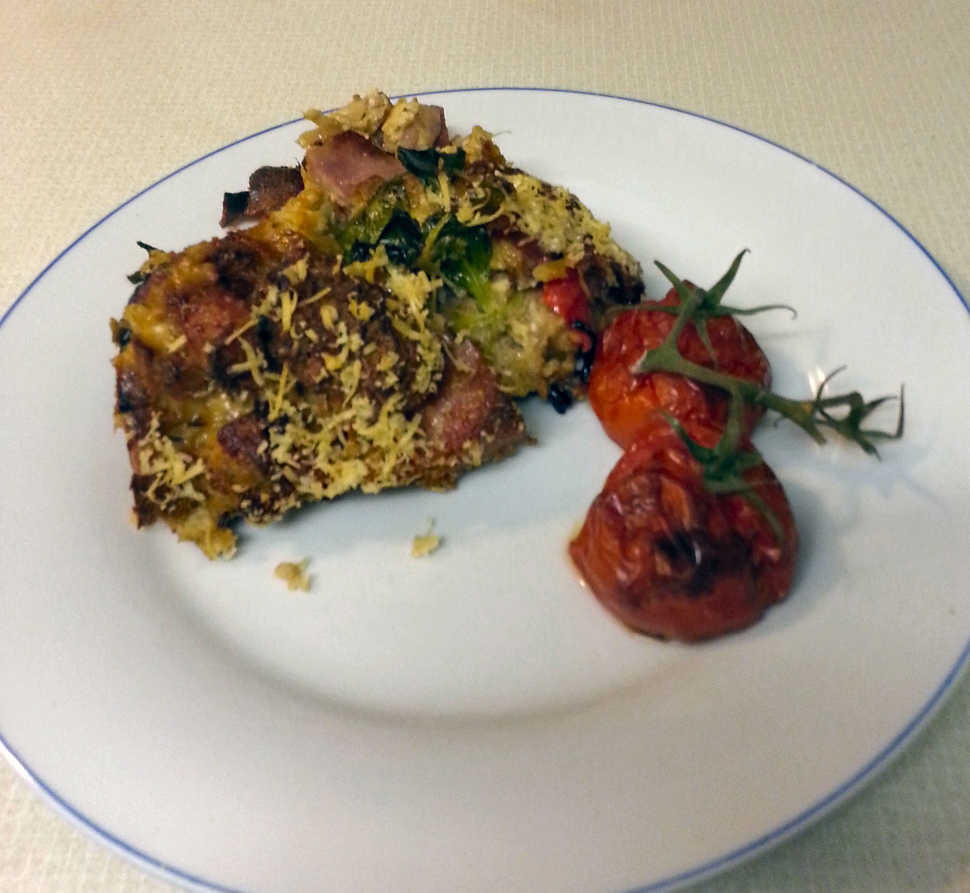Where Have All The Pumpkins Gone?

Into my spare room - mostly. In preparation for my annual Pumpkin Spectacular, because yup, it's that time of year again!
It's also close enough to my birthday to pretend that it could be my birthday party and demand presents. I got a balloon and everything.
Handily Kurt and Karen were up for a family visit at the same time - the whole gang's together again!
Perhaps that's why my schedule is a little sketchier than usual, three pairs of hands meant less meticulous planning was required.
I decided to break with tradition this year and forgo my usual roast chicken in a pumpkin, trying out a chicken casserole in a pumpkin instead. I used Tom Kerridge's recipe as my guide
the menu
Hors D'œuvres
Angels and Devils on Horseback. ON A PUMPKIN!
Starters
A Simple Greek Salad. IN A PUMPKIN.
Pumpkin Bread. FROM A PUMPKIN!
Cream of Cauliflower Soup with White Truffle Oil. IN A PUMPKIN!
Mains
Chicken Casserole. IN A PUMPKIN!
Butter Braised Green Cabbage
Fondant Potatoes
Dessert
Pumpkin Pie
Angels and Devils on Horseback. ON A PUMPKIN!
A little something to get things moving.
Starters
A Simple Greek Salad. IN A PUMPKIN.
Pumpkin Bread. FROM A PUMPKIN!
Cream of Cauliflower Soup with White Truffle Oil. IN A PUMPKIN!
Decorated with shavings from that jar of brined black truffles I've been keeping in the back of my fridge for years.
Mains
Chicken Casserole. IN A PUMPKIN!
Butter Braised Green Cabbage
Fondant Potatoes
All served with mashed butternut squash, though sadly not in a pumpkin :(
Dessert
Pumpkin Pie
With squirty maple cream.
Afterwards you could do worse than visit the fabulous Botanic Lights in Edinburgh's
Botanical Gardens, before turning all your leftovers into a
savoury bread pudding.



Chicken Casserole in a Pumpkin
main fowl meat
There's a slight problem with my idea of cooking this casserole in a pumpkin - it takes forever.
Plus you'll need a huge pumpkin - I've no idea what size casserole the guy uses.
It must be one of those you see in westerns hanging from a tripod and full of enough beans to feed a herd of hungry cowboys.
I weighed the filled pumpkin, and then calculated the cooking time at 20 minutes per pound, plus an extra 20 minutes, but it wasn't quite long enough and though the chicken was excellent, the vegetables were a little al dente for my taste. Perhaps it would have helped if there'd been a little more room in the pumpkin, but I was quite determined to get everything I'd gone to the trouble of cutting up and preparing in there, and ended up having to ram in the last few pieces pretty hard.
It probably makes quite a difference not being able to bring the contents to the boil before it goes in the oven. If I try this again I might have to consider boiling in a casserole first, then decanting into the pumpkin. Bit of a faff though!
I weighed the filled pumpkin, and then calculated the cooking time at 20 minutes per pound, plus an extra 20 minutes, but it wasn't quite long enough and though the chicken was excellent, the vegetables were a little al dente for my taste. Perhaps it would have helped if there'd been a little more room in the pumpkin, but I was quite determined to get everything I'd gone to the trouble of cutting up and preparing in there, and ended up having to ram in the last few pieces pretty hard.
It probably makes quite a difference not being able to bring the contents to the boil before it goes in the oven. If I try this again I might have to consider boiling in a casserole first, then decanting into the pumpkin. Bit of a faff though!
Serves 4-6
Ingredients
- chicken 1 medium, about 1.5kg, giblets removed
- 1 enormous pumpkin optional!
- carrots 2, each cut into 4 pieces
- celery sticks 2, tough strings removed with a vegetable peeler, each cut into 4 pieces
- white cabbage 1 small, about 350g, quartered
- leek 1, trimmed and well washed, cut into 6 pieces
- celeriac , peeled and cut into 4 pieces
- pickling onions or small shallots 8, peeled and halved
- garlic cloves 8, peeled but left whole
- salt and freshly ground black pepper
- cured garlic sausage 1, about 200g, cut into 1cm dice
- smoked lardons 100g
- thyme bunch
- rosemary 1 bunch
- fennel seeds 1 tsp
- black peppercorns 1 tsp
- star anise 1
- chicken stock 700ml
Preheat the oven to 170C/gas mark 3. Season the chicken cavity lightly with salt.
Put all of the vegetables and the garlic into a large bowl and season with salt and pepper. Toss to mix.
Scatter a layer of vegetables in the bottom of a large, heavy-based flameproof casserole Or a pumpkin! In which case cut out the lid leaving a guiding notch and a large enough hole to get the chicken through (!) and scrape out the innards. and place the chicken on top. Pack the remaining vegetables, garlic sausage and lardons around the chicken and tuck the thyme, rosemary, fennel seeds, peppercorns and star anise into the pot too.
Pour in the chicken stock. Put the casserole over a medium-high heat and bring to the boil. Cover with a tight-fitting lid. Place in the oven and cook for 1 hours. Remove from the oven and leave, covered, to rest for 20-30 minutes.
Carefully lift the chicken from the casserole and place it on to a baking tray. Use a cook's blowtorch, if you have one, to colour the skin until it's golden. (This isn't essential but it will add colour to the dish.)
Shred the chicken into large pieces and divide it and the vegetables between warmed deep plates. Ladle over some of the broth and pour the rest into a warmed jug to pass around the table.
Scatter a layer of vegetables in the bottom of a large, heavy-based flameproof casserole Or a pumpkin! In which case cut out the lid leaving a guiding notch and a large enough hole to get the chicken through (!) and scrape out the innards. and place the chicken on top. Pack the remaining vegetables, garlic sausage and lardons around the chicken and tuck the thyme, rosemary, fennel seeds, peppercorns and star anise into the pot too.
Pour in the chicken stock. Put the casserole over a medium-high heat and bring to the boil. Cover with a tight-fitting lid. Place in the oven and cook for 1 hours. Remove from the oven and leave, covered, to rest for 20-30 minutes.
It's going to take quite a bit longer to cook if you've stuffed it in a pumpkin.
Carefully lift the chicken from the casserole and place it on to a baking tray. Use a cook's blowtorch, if you have one, to colour the skin until it's golden. (This isn't essential but it will add colour to the dish.)
Shred the chicken into large pieces and divide it and the vegetables between warmed deep plates. Ladle over some of the broth and pour the rest into a warmed jug to pass around the table.
So, a bit disappointing on first attempt - but my experience of in-pumpkin cuisine is that it takes a couple of goes to get right.
Angels on Horseback
oysters in bacon
starter meat fish
Apparently this dish dates back as far as the late 19th Century,
though it's popularity seems to have mostly derived from diplomatic soirées in the 1960s
Serve a couple per person
Ingredients
- oysters
- bacon or prosciutto
- Tabasco sauce, lemon juice, hollandaise sauce optional toppings
Cut the bacon rashers into suitable sizes to wrap the oysters (you may need to cut them in half lengthways as well as crossways).
Wrap the oysters in the bacon, stretching the bacon so it self-amalgamates, and secure with a cocktail stick.
Grill the angels (or fry in a little butter) until the bacon is cooked, turning once.
Sprinkle with a little Tabasco sauce, lemon juice, dress with hollandaise sauce or serve bare now that sounds like my kind of party!, as you like.
Wrap the oysters in the bacon, stretching the bacon so it self-amalgamates, and secure with a cocktail stick.
Grill the angels (or fry in a little butter) until the bacon is cooked, turning once.
Sprinkle with a little Tabasco sauce, lemon juice, dress with hollandaise sauce or serve bare now that sounds like my kind of party!, as you like.
What's not to like?
Devils on Horseback
prunes wrapped in bacon
starter meat
A classic nibble - you can use the cocktail sticks to pin the devils to a pumpkin lid
if you want to serve them like a seventies cheese-and-pineapple hedgehog.
Serve a couple per person
Ingredients
- bacon
- prunes or chicken liver
- brandy
- mango chutney
- cocktail sticks
Soak the prunes in brandy for an hour or so. Stone them and stuff them with a spoonful of mango (or other fruit) chutney if you like.
Wrap the prunes in the bacon, stretching the bacon so it self-amalgamates, and secure with a cocktail stick.
Grill the devils (or fry in a little butter) until the bacon is cooked, turning once.
You can get your brother to do this slightly tedious job.
Other fruit are available, dried apricots for example. You are also free to invent alternative foods with which to stuff your prunes - olives, or blue cheese for instance. In some versions the prunes are filled or entirely replaced with a chicken liver.
Cut the bacon rashers into suitable sizes to wrap the prunes (you may need to cut them in half lengthways as well as crossways).Other fruit are available, dried apricots for example. You are also free to invent alternative foods with which to stuff your prunes - olives, or blue cheese for instance. In some versions the prunes are filled or entirely replaced with a chicken liver.
Wrap the prunes in the bacon, stretching the bacon so it self-amalgamates, and secure with a cocktail stick.
Grill the devils (or fry in a little butter) until the bacon is cooked, turning once.
Classic!
Fondant Potatoes
staple
There seem to be divided opinions on how best to fondant your potatoes:
If you fry them up at the end you really have to watch carefully so they don't burn.
- Fry potatoes first, then add stock and simmer.
- Fry first, add stock, then finish in the oven.
- Simmer in fat and stock, allowing to reduce then brown at the end.
- Simmer in fat and stock until it's reduced to a syrup, finish in the oven coated with the some of the syrup to glaze.
Though that last method does look good - it should only take 15-20 minutes to glaze them at 180°C, and you can boil them up ahead of time.
Felicity reckons it's a waste of a good crunchy crust pouring stock over the lovely golden potatoes you've just carefully fried up,
but I think I can see the point in a restaurant context.
It means you can safely leave them simmering for as long as you need.If you fry them up at the end you really have to watch carefully so they don't burn.
Serves 4
Ingredients
- 4 waxy potatoes (e.g Charlottes)
- thyme
- 150g clarified butter
- chicken stock or water
Peel the potatoes in broad flat strokes to give as many flat surfaces as possible. Cut in half lengthways.
Put the potatoes, flat-side down, in a deep, heavy-based frying pan just large enough to hold them in a single layer and add barely enough stock (or water) to cover them (a few bits sticking out the top are fine). Add the thyme and clarified butter. Include a crushed garlic clove if you like. Season generously.
Bring to the boil, then bubble over a high heat until the water has evaporated, leaving just the butter, and the potatoes are cooked to a golden brown on the bottom. 30-45 minutes.
Very carefully, using a palette knife, turn over the potatoes and cook for a couple of minutes until browned on the other side. Serve immediately.
Put the potatoes, flat-side down, in a deep, heavy-based frying pan just large enough to hold them in a single layer and add barely enough stock (or water) to cover them (a few bits sticking out the top are fine). Add the thyme and clarified butter. Include a crushed garlic clove if you like. Season generously.
Bring to the boil, then bubble over a high heat until the water has evaporated, leaving just the butter, and the potatoes are cooked to a golden brown on the bottom. 30-45 minutes.
Very carefully, using a palette knife, turn over the potatoes and cook for a couple of minutes until browned on the other side. Serve immediately.
They're most excellent when you get them right, but it's very easy to under-cook them, and they over-cook quickly too
- so you'll need to watch them like a hawk when they start roasting.
Simple Greek Salad
salad veg cheese
Serve in a beautifully carved pumpkin for presentational points.
Or just get your sister to chuck it in a pumpkin any-old-how.
Or just get your sister to chuck it in a pumpkin any-old-how.
Serves 8
Ingredients
- 200g feta cheese, cubed or crumbled
- about a dozen small tomatoes, quartered
- ½ cucumber, peeled if thick, sliced, quartered
- ½ red onion, sliced spring onions are also acceptable
- 2 dozen of those brined black olives you brought back from Greece, stoned, halved
- couple teaspoons capers, drained
- soft lettuce leaves
Dressing:- a few tablespoons red wine vinegar
- about twice as much olive oil
- salt & pepper
- couple sprigs of fresh oregano, leaves only roughly chopped
- splash lemon juice optional
- a dash of Ouzo or similar e.g. Pastis
Halve or quarter the tomatoes.
If they're not really ripe you can encourage them along by sprinkling over a little sugar
and leaving them to macerate.
Peel the cucumber if the skin is thick or ugly, cut into slices and quarter them.
Thinly slice the red onion.
Pick the oregano leaves and roughly chop them.
Line your serving dish (or pumpkin!) with lettuce leaves, add the salad ingredients, dress, serve.
Peel the cucumber if the skin is thick or ugly, cut into slices and quarter them.
Thinly slice the red onion.
You can soak it in the dressing if you want to soften it a little.
Halve or quarter the black olives, discarding the stones.Pick the oregano leaves and roughly chop them.
If you can't find fresh oregano don't bother.
Whisk up the dressing with the oregano and lemon juice to taste. Season, and add some Ouzo if you like. Line your serving dish (or pumpkin!) with lettuce leaves, add the salad ingredients, dress, serve.
Add the feta at the end to avoid discolouring it. It will look more attractive just scattered on top, perhaps with a few reserved oregano leaves.
Simples.
Simples.
Savoury Bread Pudding
main meat cheese
Apparently this American dish is known as a strata, especially when the ingredients are layered.
It isn't exactly a delicate gourmet dish, but it seems very flexible and is an excellent way to use up leftovers, even your salad. Probably you could incorporate any kind of meat, vegetables, mushrooms or cheese, and use any kind of bread.
I just used what I had. Which included quite of a lot of bread ;)
It isn't exactly a delicate gourmet dish, but it seems very flexible and is an excellent way to use up leftovers, even your salad. Probably you could incorporate any kind of meat, vegetables, mushrooms or cheese, and use any kind of bread.
I just used what I had. Which included quite of a lot of bread ;)
Serves 4
Ingredients
- 1 loaf bread, cubed
- olive oil
- garlic sausage, pancetta or other meat, roughly chopped or minced
- onion, thinly sliced
- 3 garlic cloves, sliced
- thyme some lovage might be nice!
- ½ cauliflower, broken into florets
- red pepper, chopped
- 6 eggs
- 1½ cups cream
- 1 cup milk or as necessary
- lambs lettuce
- salt & pepper
- Parmesan or other cheese, about 2 cups, grated
Pre-heat the oven to 350°F/177°C/Gas Mark 4.
Remove the bread crusts and cut into chunky cubes, mix with a little olive oil and some thyme and bake in the oven until they brown a little. Set aside.
Slice the onions reasonably thinly (or you could chop them slightly chunkier), fry them in oil or butter until soft, adding thinly sliced garlic towards the end. Set aside.
Chop the red pepper and fry in a little oil or butter until softening. Set aside.
Break the cauliflower into florets, and fry over a high heat until they begin to brown nicely, then lower the heat, cover and cook gently until softened.
Beat up the eggs with cream and milk, season lightly and stir in half or all the grated cheese. Mix all the ingredients, including the lettuce and any extra herbs and fill a baking dish. Cover and refrigerate for a few hours to allow the bread to absorb some liquid. You can keep it at this stage for a day or two - the mixture should be moist but not too sloppy.
Scatter over the remaining cheese if you have any. Bake at 350°F/177°C/Gas Mark 4 until puffed, golden brown and just set - 1 to 1½ hours (turn the oven down if it darkens too quickly and is still runny inside).
Remove the bread crusts and cut into chunky cubes, mix with a little olive oil and some thyme and bake in the oven until they brown a little. Set aside.
This step is definitely optional - I'm not entirely sure what difference it will make in the end.
Cut cured meat (garlic sausage or pancetta) into chunks, or mince raw meat (pork or sausage) and fry until browned or cooked, respectively.
Set aside.Slice the onions reasonably thinly (or you could chop them slightly chunkier), fry them in oil or butter until soft, adding thinly sliced garlic towards the end. Set aside.
Chop the red pepper and fry in a little oil or butter until softening. Set aside.
Break the cauliflower into florets, and fry over a high heat until they begin to brown nicely, then lower the heat, cover and cook gently until softened.
Beat up the eggs with cream and milk, season lightly and stir in half or all the grated cheese. Mix all the ingredients, including the lettuce and any extra herbs and fill a baking dish. Cover and refrigerate for a few hours to allow the bread to absorb some liquid. You can keep it at this stage for a day or two - the mixture should be moist but not too sloppy.
Scatter over the remaining cheese if you have any. Bake at 350°F/177°C/Gas Mark 4 until puffed, golden brown and just set - 1 to 1½ hours (turn the oven down if it darkens too quickly and is still runny inside).
Excellent.
Not entirely sure about scattering cheese on top vs. mixing the cheese in - it might look better without the burned-looking cheese crust.
It's good to roast some tomatoes to go with the bread pudding which can be quite salty and stodgy on its own.
Not entirely sure about scattering cheese on top vs. mixing the cheese in - it might look better without the burned-looking cheese crust.
It's good to roast some tomatoes to go with the bread pudding which can be quite salty and stodgy on its own.




